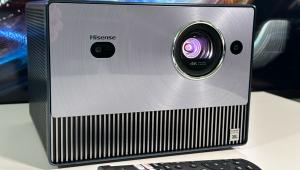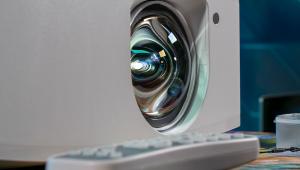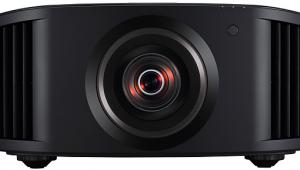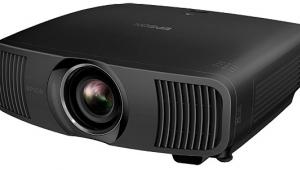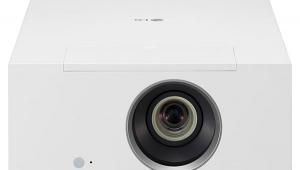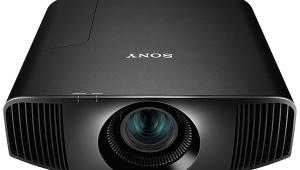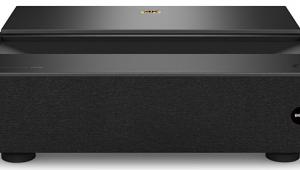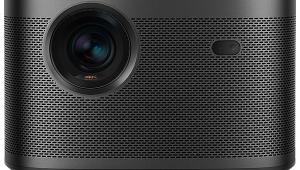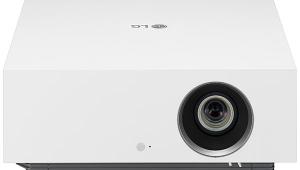JVC DLA-RS1100 4K D-ILA Projector Review Test Bench
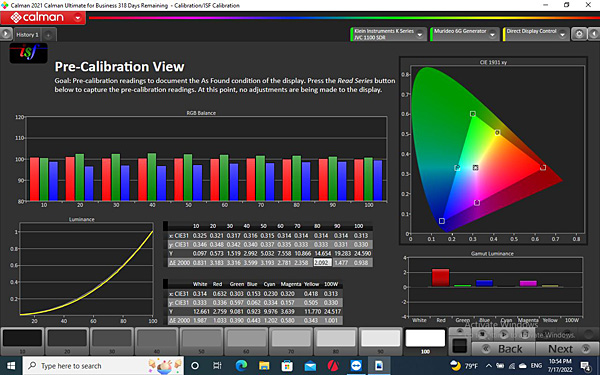

HD/SDR
Full-on/full-off contrast ratio (SDR): unmeasurable
These measurements and charts were produced using Portrait Display's Calman software, together with X-Rite i1Pro 3 and Klein K-10A color meters and a Murideo test-pattern generator. The measurements were taken on a 96-inch-wide, 1.3-gain Stewart Filmscreen StudioTek 130 screen.
The standard dynamic range (SDR) peak white reading for this measurement (with the projector's iris on manual and wide open) was 27.6 ft-L (94.7 nits). The black level was 0.000 ft-L. These numbers were read from the Stewart screen using the Klein meter. While the black level in SDR was barely visible to the naked eye in a totally dark environment on a full black screen, it was unmeasurable with the Klein meter.
The charts shown here are for SDR. Before calibration in the SDR Cinema Picture Mode, with some minor adjustments but no color calibration, grayscale Delta E figures ranged from a minimum of 1.15 at 100% to a maximum of 3.83 at 40%. After calibration with the Color Temp controls, the minimum and maximum grayscale Delta E figures were 0.7 at 80% and 1.6 at 20%, respectively. The color Delta E figures were all so low out of the box (a low of 0.13 for yellow and a high of 1.46 for cyan) that no color-management calibration was applied with the Color Profile controls.
The results of a saturation test, as color saturation increased by 20% steps, were good, though slightly undersaturated at less than peak output in red, magenta, and blue. A color checker test, which checks for the accuracy of a wide range of real world colors, was satisfactory but not exceptional, with an average Delta E of 3.4 and a maximum Delta E of 5.3.
The JVC passed the 3:2 HD, MA HD (motion adaptive HD), and 2:2 pulldown in our HD/SDR video tests. It won't accept a native 480i input; you have to upconvert older material such as DVDs externally — most Blu-ray players can do this. The RS1100 also passed both luma and chroma resolution tests.
(Delta E is a figure of merit indicating how closely the result matches the target value. Delta E figures below 3 — some experts allow for 4 — are generally considered visually indistinguishable from ideal.)
HD/HDR
Full-on/full-off contrast ratio (HDR): 19,797:1
Our objective results when calibrating the JVC using Calman calibration software were poor. JVC's recommendations involved the use of special JVC calibration software that we didn't have — software that, in any event we were informed (independent of JVC) isn't compatible with our color meters. I soldiered on using JVC's recommendations for setting brightness and contrast, but proceeded from that point using Calman. The results were still clearly unusable.
At that point, I determined that the subjective settings I had used early on for HDR were my best option. The results with these settings were excellent, as described in the main text of the review. (These settings will appear in the online posting of the review on soundandvision.com.) If you choose to have the JVC calibrated by an Imaging Science Foundation (ISF)- or THX-trained technician — something we certainly recommend — make sure you put at least 200 hours on the lamp before calibration. (For most of the results in this review, subjective and objective, the lamp hours exceeded 200).
This largely subjective setup process limited the objective HDR measurements available to us. As measured off the screen using a Konica Minolta LS-100 luminance meter, the peak luminance was 136.6 nits and the black level 0.0069 nits, resulting in the full on/full off contrast ratio shown above. The peak luminance didn't vary with window size (unlike a flat-panel TV, the output of a projection lamp isn't affected by the size of the white window). The JVC covered 70.1% of the BT.2020 color space and 93.6% of P3. Virtually all consumer HDR source material uses P3.


